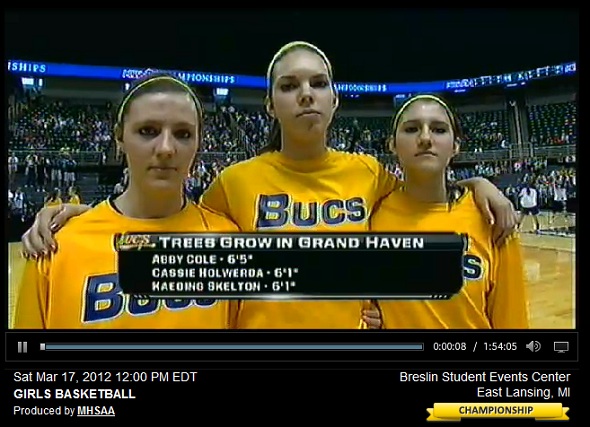
#SocialStudies v7.0
March 29, 2012
 It's been a wild couple weeks for us here in the office -- and we know you've been missing your weekly lineup of viral video goodness.
It's been a wild couple weeks for us here in the office -- and we know you've been missing your weekly lineup of viral video goodness.
Not to worry.
We're back, and with a vengeance. Not Bruce Willis-style, but close to it.
1. Grand Finale
Easily the most intense game from Basketball Finals (both Boys and Girls) was the Class A Girls Final between Grosse Pointe South and eventual champion Grand Haven.
Here's the archived video of the entire game -- I'll recommend speeding through to the last 10 minutes. Grand Haven roared back from 18 points down to give us some serious drama in the final minute of play. Oh, and Bucs senior Shar'Rae Davis? Full-court drive and the game-winning bucket with under 10 seconds to play? Pretty nice little memory you've got there, girl. Great game.
(Also, tune in at 47:50 to catch the touching story of Terry Reid and his grandson Kyle Hall. Click the photo below for a link to the video.)
2. Must be the thin air
We're not the only state with drama in championship games this month ... the 2012 Colorado State High School Athletic Association 5A Boys Basketball Championship ended on this ridiculously athletic circus tip-in. Congratulations to Chaparral High School. (Seriously, how long was that kid in the air???)
3. Because Ray said so
Ray Lewis, controversial as his persona is, can flat-out deliver a pep talk. This rivals anything I've seen in film as one of the best brief amp-you-up-to-run-through-a-wall hype chats ever.
For the record, Stanford went on to win their NIT semifinal over UMass, 74-64. Also, for the record -- I am definitely "not okay with mediocre" today.
4. Nothing but ... no way!
And finally, here is one way to become famous in 3rd grade if your name isn't Doogie Houser.
Remember: if you find something you think should make the grade here on #SocialStudies, send it on over!
Like us on Facebook and follow us on Twitter @MHSAA.

Today in the MHSAA: 10/24/24
By
Geoff Kimmerly
MHSAA.com senior editor
October 24, 2024
1. BOYS SOCCER No. 2 Flint Powers Catholic edged No. 3 Imlay City in a Division 3 Regional Semifinal – Port Huron Times Herald
2. BOYS SOCCER No. 5 Mason advanced in its Division 2 Regional with a shootout win over Bloomfield Hills Cranbrook Kingswood – Oakland Press
3. BOYS SOCCER Top-ranked Pontiac Notre Dame Prep downed Frankenmuth 4-1 in Division 3 – WJRT
4. BOYS SOCCER No. 4 Allendale downed Coldwater 3-0 in a Division 2 Regional Semifinal – WTVB
5. VOLLEYBALL Division 1 honorable mention Traverse City Central finished a season sweep of rival West – Traverse City Record-Eagle
6. VOLLEYBALL Alpena came back from losing the first set to defeat Gaylord in four on Senior Night – Alpena News
7. VOLLEYBALL Hancock earned a road sweep at Lake Linden-Hubbell – Houghton Daily Mining Gazette
8. VOLLEYBALL Midland Bullock Creek and Beaverton earned Jack Pine Conference sweeps – Midland Daily News


